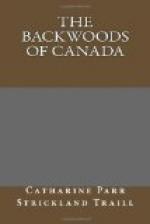After the burning is over the brands are collected and drawn together again to be reburnt; and, strange as it may appear to you, there is no work that is more interesting and exciting than that of tending the log-heaps, rousing up the dying flames and closing them in, and supplying the fires with fresh fuel.
There are always two burnings: first, the brush heaps, which have lain during the winter till the drying winds and hot suns of April and May have rendered them sear, are set fire to; this is previous to forming the log-heaps.
If the season be dry, and a brisk wind abroad, much of the lighter timber is consumed, and the larger trees reduced during this first burning. After this is over, the rest is chopped and logged up for the second burning: and lastly, the remnants are collected and consumed till the ground be perfectly free from all encumbrances, excepting the standing stumps, which rarely burn out, and remain eye-sores for several years. The ashes are then scattered abroad, and the field fenced in with split timber; the great work of clearing is over.
Our crops this year are oats, corn, and pumpkins, and potatoes, with some turnips. We shall have wheat, rye, oats, potatoes, and corn next harvest, which will enable us to increase our stock. At present we have only a yoke of oxen (Buck and Bright, the names of three-fourths of all the working oxen in Canada), two cows, two calves, three small pigs, ten hens, and three ducks, and a pretty brown pony: but she is such a skilful clearer of seven-railed fences that we shall be obliged to part with her. Breachy cattle of any kind are great disturbers of public tranquillity and private friendship; for which reason any settler who values the good-will of his neighbours would rather part with the best working yoke of oxen in the township, than keep them if they prove breachy.
A small farmer at home would think very poorly of our Canadian possessions, especially when I add that our whole stock of farming implements consists of two reaping-hooks, several axes, a spade, and a couple of hoes. Add to these a queer sort of harrow that is made in the shape of a triangle for the better passing between the stumps: this is a rude machine compared with the nicely painted instruments of the sort I have been accustomed to see used in Britain. It is roughly hewn, and put together without regard to neatness; strength for use is all that is looked to here. The plough is seldom put into the land before the third or fourth year, nor is it required; the general plan of cropping the first fallow with wheat or oats, and sowing grass-seeds with the grain to make pastures, renders the plough unnecessary till such time as the grass-lands require to be broken up. This method is pursued by most settlers while they are clearing bush-land; always chopping and burning enough to keep a regular succession of wheat and spring crops, while the former clearings are allowed to remain in grass.




